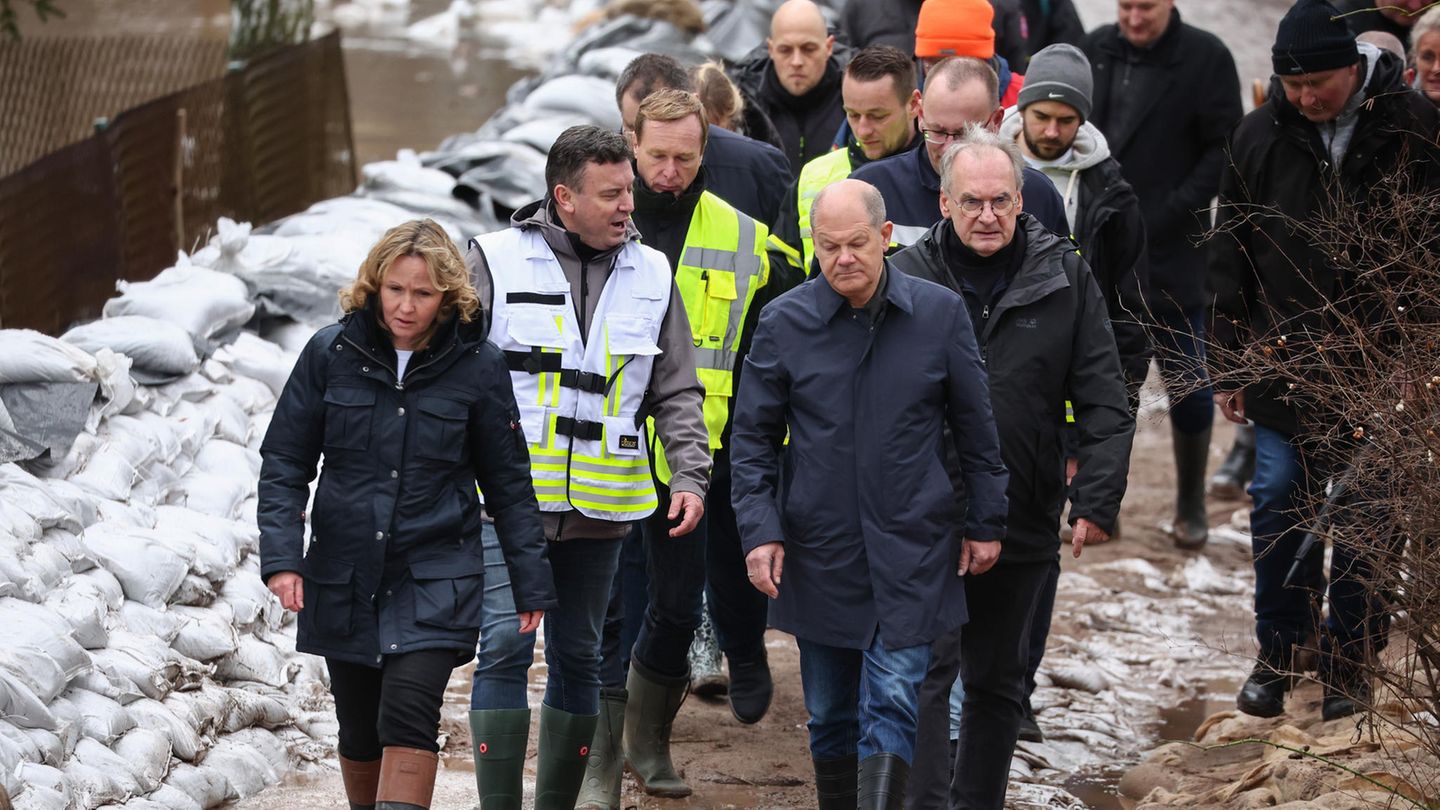On New Year’s Eve he was in Verden an der Aller, now in Sangerhausen an der Helme: The Federal Chancellor was worried about the floods at the beginning of the year. He has thanks and recognition for the numerous helpers.
Olaf Scholz wears rubber boots. When the Chancellor comes for his second flood visit, his footwear could be a sign of the situation that has become even worse in recent days – in Verden an der Aller near Bremen he was still without boots on New Year’s Eve. Scholz has little interest in the boot issue and did not want to comment on it when he took a serious look at the situation on the Helme in the town of Oberröblingen in Saxony-Anhalt on Thursday.
When the Chancellor landed in Sangerhausen by helicopter from Berlin, it was cloudy and rainy – as it had often been in the past few days. The small river Helme, otherwise only about two meters wide, has overflowed its banks many times over.
Scholz, Environment Minister Steffi Lemke (Greens) and Prime Minister Reiner Haseloff (CDU) are shown a dike that is in danger of breaking – and above all they listen and ask questions. For example, you want to know whether there are enough sandbags in stock.
Flooding in Germany for weeks
This question also concerns people in other regions of Germany, which have been struggling with flooding for almost two weeks. In Lower Saxony, the continuous rain of the past few days is causing water levels to rise again, particularly in the catchment areas of the Hunte rivers near Bremen and Hase in Emsland. In some places, residents are still unable to return to their homes.
In Bavaria, the situation has worsened, especially in the north, in Franconian regions and in parts of the Upper Palatinate. Some rivers in Rhineland-Palatinate are also significantly fuller. In North Rhine-Westphalia, a spokesman for the Ministry of the Environment reported rainfall amounts of up to 35 liters per square meter within 24 hours. However, the water levels that have risen again across the country have not yet reached the dimensions of the Christmas flood.
In other federal states, the situation has at least not worsened: for example in Hesse, where the rivers Fulda, Lahn, Eder and Kinzig and their tributaries are still affected. In Saarland, the water levels of the Prims, Oberer Blies and Nied rivers have reached their peaks and are falling.
Floods
Flooded streets, emergency dikes, constant rain warning: pictures from the flood areas
No friendly reception for Olaf Scholz
Tens of thousands of helpers are deployed nationwide. Chancellor Scholz speaks to some people during his visit to Saxony-Anhalt. The approximately 1,600 residents have been in a state of alarm since Christmas. “What we need is better coordination. Nobody here knows what everyone else is doing,” says a resident. Scholz feels the displeasure immediately after his arrival. Shouts of “Go back straight away” can be heard. But there are also words of thanks, especially from the professional helpers.
The Chancellor was impressed by the solidarity on site. “This spirit of solidarity will also apply afterwards, and we will not leave anyone alone,” says Scholz, who is now wearing lace-up shoes again. He also promises support in later repairing the damage. “It is clear that this will only happen together, and it must also be done in solidarity in Germany.”
Lemke points out on site: In the medium and long term, there must be an agreement between municipalities, states and the federal government on how to better prepare for such events. “The water needs space, you can see that here,” she says. It will also be about “how help can be given, where help needs to be provided, financially but also in other ways”.
Floors wet like a sponge
The impressions that Scholz collects on site in the south of Saxony-Anhalt are enormous: flooded meadows and a significantly wider ridge over which the drainage from the southern Harz runs. The floors are wet like a sponge. The campsite at the Kelbra reservoir is under water. The people in the region have repeatedly experienced flooding in recent years – but it was nowhere near as bad or lasting as this time, says District Administrator André Schröder. The Bundeswehr will be deployed from Monday.
According to the local farmers’ association, almost every farmer in Lower Saxony is currently affected by flooding of their fields or damage caused by moisture. “Several hundred thousand hectares of fields and grassland are flooded,” says Landvolk President Holger Hennies to the German Press Agency. Hundreds of farms were also affected by flooding, “but fortunately only a few farms were so badly affected that stables were also affected and livestock had to be evacuated.”
Pastures and meadows, arable land sown with grain or rapeseed as well as areas with sugar beets or potatoes – in many areas farmers fear a total harvest failure. In addition, management is made massively more difficult by the constant rain, explains the plant expert from the Lower Saxony Farmers’ Association, Karl-Friedrich Meyer. According to Meyer, winter grains, i.e. plants that were sown in autumn, “suffocate” when areas are under water for around ten days. Around 20 percent less yield must also be expected for summer cereals.
Rain turns into snow
The German Weather Service (DWD) has warned of continuous rain. Now it’s supposed to get colder. “Precipitation is decreasing more and more in the affected flood areas and turning into snow,” the DWD announced on Thursday. Winter is returning, it is becoming increasingly cold and icy. It initially remained unclear what effects the sub-zero temperatures would have on the flooded areas.
Source: Stern
I have been working in the news industry for over 6 years, first as a reporter and now as an editor. I have covered politics extensively, and my work has appeared in major newspapers and online news outlets around the world. In addition to my writing, I also contribute regularly to 24 Hours World.




